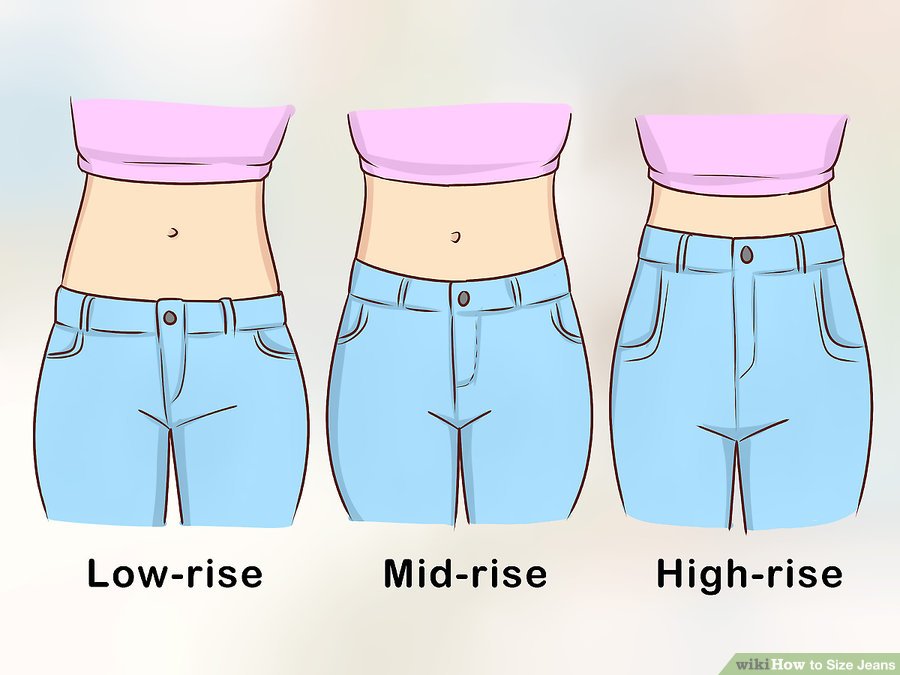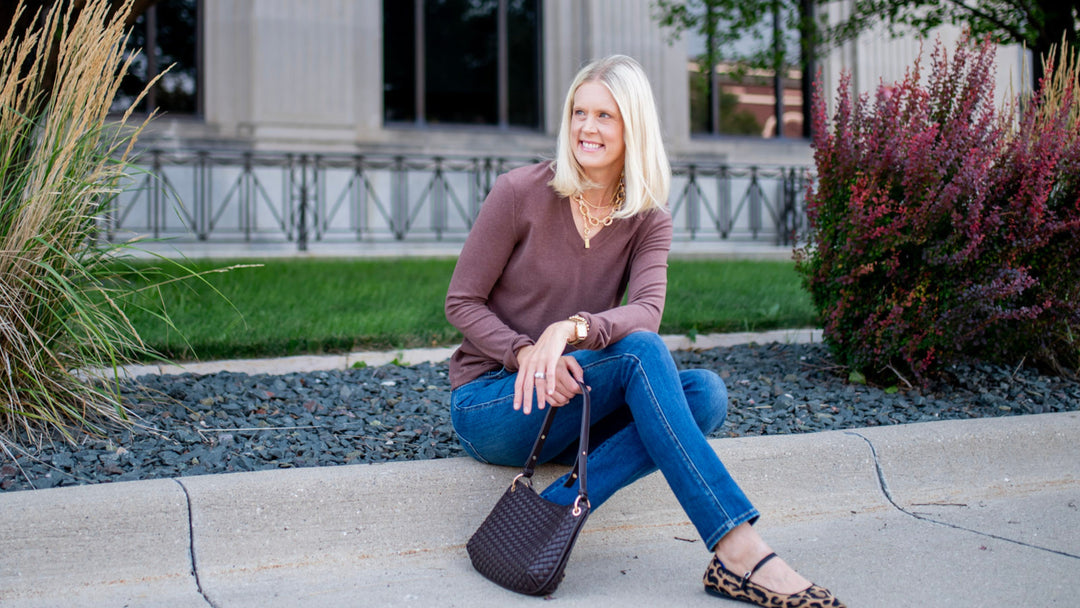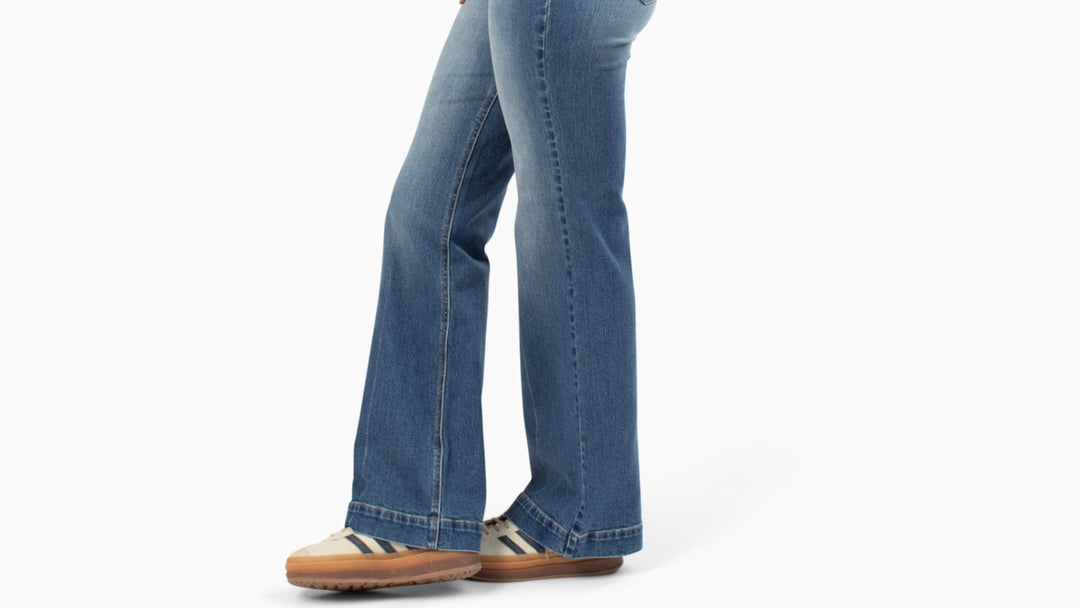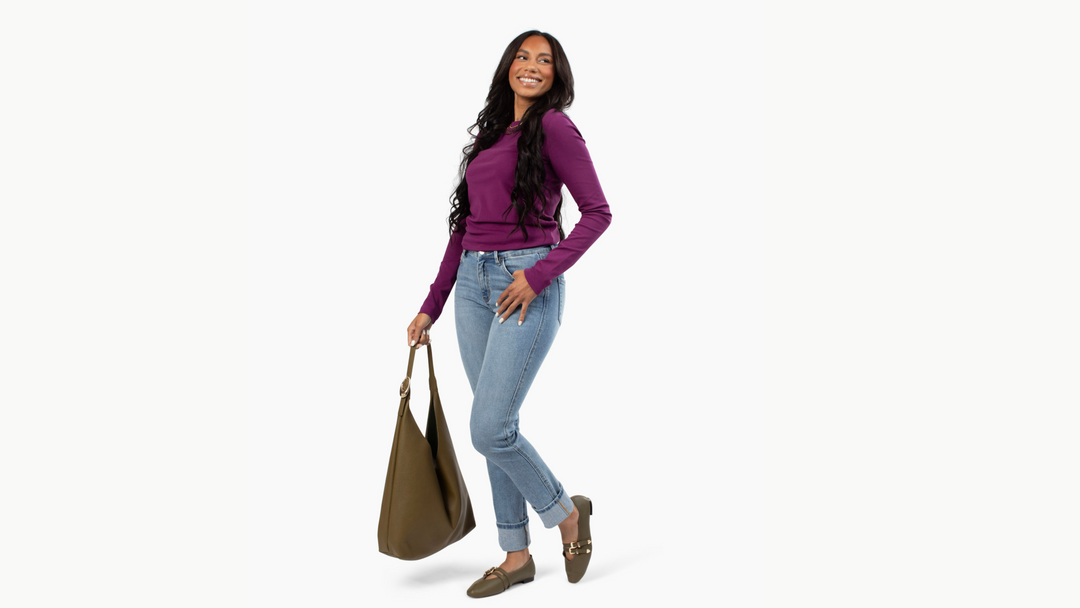Online Guide To Denim Shopping for Tall Women
A few years ago we put together a guide to help make shopping online a little bit easier, not only for our fellow tall girls but truly for anyone who buys clothing online! We reviewed different key measurements and tips to know to help everyone take some of the guesswork out of what you are purchasing. If you haven't had a chance yet to look that over, we highly recommend it, click here to give it a read. After launching our denim line for tall women, we felt like there was an opportunity to come back and do the same thing, but focus specifically on pants. Everything that we are going to tackle in this guide came to be either from our own epiphanies during the design process or from customer experiences and/or FAQs. Our hope is it will help to educate everyone and make shopping online a little easier!
Understanding the Differences in Rises
Okay my friends, let’s get right down to it. Understanding the definition of pant rises is a critical step to anticipating whether the fit of a jean or pant or any type of bottom will be a good match for you. The rise of a pant is defined as the length between the crotch seam (right between the legs) and the top of the waistband. I realized during our manufacturing process that I didn’t really know where certain categories of rises were supposed to fall on me, because for basically all of my life, I was wearing jeans manufactured for the general market, but with a few extra inches added to the bottom hemline and tagged as “women’s tall jeans.” But here’s why that situation can cause problems or confusion for us as tall women: the brand may determine that a certain style they are producing is a mid-rise jean because of where it hits their fit model. That fit model is likely at least 8” shorter than me (usually more, but I’m being really conservative here), so though it’s a mid rise on her, it’s extremely possible that it’s closer to a low-rise on me. But because this style was either named mid rise or described that way in the production description on the website, I just automatically took that to mean that was a mid rise on me. I literally never considered the fact that it really was closer to a low rise on my body!
So with that in mind, let’s take a moment to define what the actual rises of pants are and understand that a retailer may unintentionally mislead us because of how an item works for the person they designed it on. That’s a SUPER important thing to understand!

Low Rise
Low rise pants are defined as those that sit at or below the hip.
Mid Rise
Mid rise pants are defined as those that sit between the hip and the belly button. If you have a pair of pants just above your hip bone, these are generally considered to be mid rise.
High Rise
High rise pants are defined as pants that hit close to your belly button.
THIS Topic is Very Important to Understand
Now, here’s the other very important thing to take away from this and by very important, I mean absolutely direly critical. Most times when you go online and read descriptions about the various rises and their definitions, you’ll find that they give rise lengths that also correlate to that specific fit. For instance, they may say that a mid rise is a rise that is around 8.5” in length. But, where 8.5” falls on you and me may be very different than where it falls on someone who is 5’5”! We all have vastly different proportions (even as tall girls and women!) so we have to stop taking a product name or a company’s description of a product as the gospel to what the product is for our personal bodies. We have to take it a step further. I would implore each and every one of you to take a second and think about where you like your jeans to hit on your waistline. Then take another second and actually determine what that measurement is in length. Because that is going to help you beyond measure when you assess if a pair of jeans would potentially be a good match for you! If you know that you really prefer a rise of at least 9.5”, then ordering anything under that won’t feel good to you and it’s not worth your time to even try. I realized what was happening to me over the years was that I was buying pants labeled by the retailer as mid rise when in reality, they were much closer to a low rise instead on my actual body! So let’s take a second to go back to the description I mentioned above, where mid rise is around 8.5” in length. That particular rise length of 8.5” is in fact basically a low rise pant for me – because it hits me at or below my hip bones! My proportions are longer than many women so that numerical definition of mid rise does NOT APPLY to my body and my proportions! However, your proportions may be different. You might have incredibly long legs and shorter torso. So, the 8.5” rise may in fact be a mid-rise for you. See what I’m saying here?! This is so, so important to understand and begin to apply to your own body and proportions!! I did not even realize the depths of all of this until we were forced to work through where we wanted the waistline to hit on our line of tall denim and then it was a HUGE epiphany!
In our Blakely Skinny Jeans, we determined that we wanted the rise to be 10.5” because that’s a beautifully comfortable fit for many tall girls and women who do have a longer torso length. And, we have gotten a lot of confirmation of that from women who have purchased and tried them on. But keep in mind, NOT all tall women and girls have the same torso proportions. That’s why we always say, there’s not one size or proportion or length for tall. So I would again really encourage all of you to determine where a 10.5” rise would fall on you and determine if that’s a comfortable fit for you! The Blakely rise, if I’m being honest, isn’t even ultra high rise because it still hits me below my belly button. But for some people, it may hit substantially above it. That's another instance where it's more of a mid rise for me, but a real high rise for someone else. Taking the time to understand what your ideal measurements are will help you from the get-go to understand whether this is an item worth trying or not! And then once you know what your specific measurements and preferences are, make sure to look for that every time you shop online for any pair of pants. Most retailers will supply this information in their product descriptions, so make sure to always check for that mentioned there. If a retailer doesn't give you a specific measurement, you cannot trust that their assessment of a rise fit will be the same on your body!! We would caution you to find out this information prior to purchasing.
Definition of Skinny Jeans & How to Determine How Fitted They Are
I think most of us probably understand (even if we don’t know the precise definition) that a skinny jean is defined as a tight-fitting jean with narrow legs. If you want to get even more technical, you can break this down further into two categories: the cigarette leg and the legging. A cigarette leg is a skinny jean that doesn’t have as tight a leg opening at the bottom, so as a result it may not grab the calf quite as tightly as a legging would. A legging, on the other hand, does exactly what you think. It’s VERY fitted all the way down, including through your calf. Now with all of that in mind, it’s the size of the leg opening that is the biggest determinant of how fitted the leg will be. That’s because with a skinny jean the size of the leg opening determines how aggressive the fit below the knee will be. If you have a very small leg opening, then it’s going to be VERY fitted starting from the knee to achieve that proportional tapering down to the opening. If the opening is less small, it doesn’t have to be as aggressive. Does that make sense?
Again, bringing it back to our Blakely Skinny Jean, we actually opted to make the leg opening 11” wide. We will be the first to acknowledge that opening is larger than some of skinny jeans on the market. Most skinny jeans have a leg opening of around 10” – we intentionally decided to go a little wider BECAUSE…..most of us have larger feet to better balance our tall frames. Have you ever had a moment where you tried on a pair of ultra-skinny jeans and then about fell to your death trying to get them off or over your feet? Because same! In fact, last year we were at a factory of one manufacturer and I was trying on another sample pair to review the fit. And I could NOT get them off my foot to save my life. I’m talking, I was THIS CLOSE to coming back out and telling them I needed a pair of scissors to cut them open to save myself. Somehow (I’m still not even sure how) I did ultimately manage to peel them off, but it wasn’t pleasant and it wasn’t something I wanted to experience each and every time I wear a pair jeans. If you have a pair of jeans that you LOVE with how they fit around your legs, then I highly encourage you to take note of what the leg opening is. Then keep that in mind when you are shopping in the future for other pair of jeans. The leg opening is going to tell you everything about how fitted your pants will be, and whether they are closer to a cigarette leg or a true legging leg.
Let’s Get Real About Inseam Length
I’m going to need some of you to sit down for this (if you aren’t already), but there’s a very, very, very popular misconception among our niche of long-legged beauties that because you are “tall” ….. you absolutely always need the longest inseam ever made on Earth. Okay maybe that’s a bit of an exaggeration, but the point I’m trying to make is that so very often we encounter situations with customers where they assume they need the longest version of whatever it is that we make, and many times….they don’t. Now don’t “at me” because I know there are some women who DO need it, but more often than not, they just don’t. I’m not pulling this out of the clear blue sky, this comment is based on five years of customer interaction and history.
Another point that I would like to drive home is that none of us have just one standard inseam length. It’s not possible. And the reason is because a skinny pant is never, ever going to reach the floor because the small leg opening is never going to allow it to drape over the foot and hit the ground. However, a straight leg or a bootcut leg will. So when I wear a pant that is intended to reach the ground, I need an extra 3.5” in inseam length versus when I wear a skinny pant that goes to the top of my foot. What we end up seeing often times is that someone will tell us they are a 37” inseam, which may be the absolutely perfect length on a straight leg pant because it skims the floor beautifully. However, when they put on a 37” skinny jean, it does this funky bunching thing at the bottom of the leg. And that’s because the pant is actually too long!! I think there are a lot of tall girls and women who feel comforted by the bunching because they feel like they finally have all the length they need. However, they would be better served either reducing the inseam length or hemming them (which costs almost nothing!!).
A BIG Something That We Learned
I am going to admit something to you that we also realized in producing our own denim line. Most, if not ALL, brands misrepresent their inseam lengths. When we started comparing our 35” inseams to other retailer’s 35” inseams, ours was always longer. By sometimes 2-3”! We actually couldn’t believe it. We have no idea why or what the rationale is behind this, but I can say with absolute certainty that ours is a genuine 35” length. And 37” length. You can put the tape measure down and verify as well. Our takeaway is that this may cause many people to have a false idea of what their actual inseam may be, as they've been gauging it based on a retailer's alleged inseam.
By taking a few minutes to understand not only your own specific measurements but also the measurements behind your fit preferences is going to take so much guesswork away when evaluating jeans and pants online. We get a bunch of request each week to see various items on women of all sizes and heights, and we totally understand that it can be helpful to see how items fit someone built simiarly. But honestly, sometimes just taking the time to understand the key measurements of an item are just as helpful, if not more. Because though someone may be the same jean size as you, they may still have different torso proportions and whatnot, and that will change the fit between two people. I think sometimes we probably sound like a broken record, but there isn't one version or proportion to "tall", so it's imperative to know the measurements that are critical for you.


